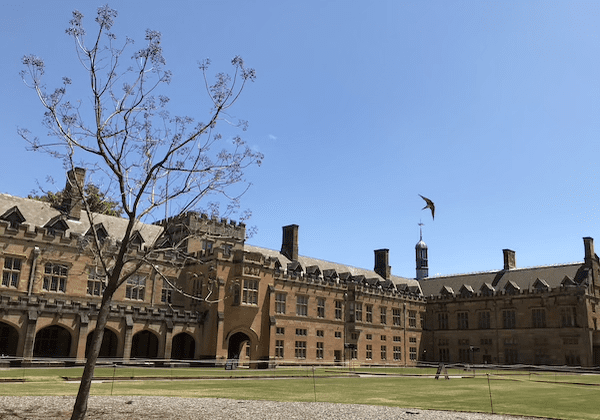A small and feathered family has lived in the Quadrangle for decades. Less vindictive than magpies and far more endearing than ibises, welcome swallows are some of the University’s less heralded residents.
Over the course of a warm day, I watch a group of a half-dozen swallows swoop above the Quad, regularly returning every few minutes to tend to their nest, before departing on another frenetic sortie around the spires of MacLaurin Hall.
The swallows are tiny but extremely agile, with dark wings and orange faces. Despite constant close passes to the ground, the swallows rarely land. Their acrobatic flying helps to catch insects midair while eating their own body weight in food each day, a feat made easier by their all of 10 grams.
According to Professor Dieter Hochuli of the School of Life and Environmental Sciences, “they have probably been on the site longer than we have. I’ve been here for 26 years and they’ve always been around.” The Yeoman Bedell beneath the clocktower agrees, telling me that the birds have been here “a very long time.”
The birds take up residence in the Quad during the breeding season between August and February each year, before moving north for the winter and returning to the same nesting place ahead of spring.
According to Professor Hochuli, “these birds often breed close to human structures, making cup-shaped nests of mud and grass, lined with feathers and even fur. They attach their nests to suitable structures, such as buildings or bridges in urban ecosystems, or to vertical rock walls.”
Wikipedia cheerfully relates that “in swallows’ excreta, there are various kinds of bacteria and parasites. The nests tend to breed all kinds of bacteria and parasites causing very severe diseases, for example: histoplasmosis, encephalitis, salmonella, meningitis, toxoplasmosis, etc.”
Indeed, the nest I find near the jacaranda in the Quadrangle’s southeast corner is not a sight to behold, though tiny chirps of new hatchlings come from within.

Yet despite their apparently septic abodes, watching the swallows flit around the Quad and weave through its columns is a soothing experience.
Given the shutdown of campus, the swallows and I are the Quadrangle’s only occupants for hours. They pay me little heed, seemingly both uninterested and unperturbed by my presence. A light breeze and the swallows’ calls are the only sounds. Like their movements, the call of a welcome swallow is energetic but light, and almost constant.
Within a structure noted for its cold sandstone and imposing features, the swallows are a delightful burst of levity as cloisters and turrets become an entertaining obstacle course. It is only once the sun sets that they are finally still, returning to the nest as silence descends for the night on the Quadrangle lawns.





